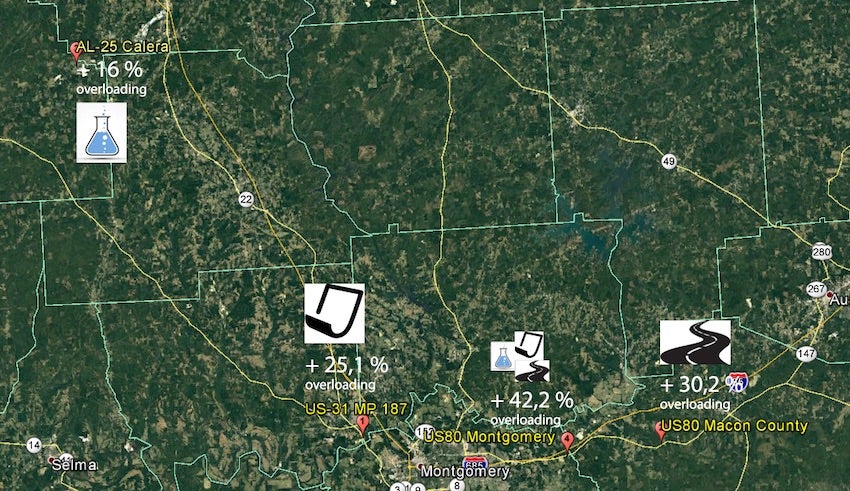Weigh-in-motion (WIM) techniques have been traditionally used for measuring vehicles weights while travelling at highway speed. WIM systems provide detailed data on gross weights, individual axle loads, velocities and axle spacing of almost all vehicles passing the system. Bridge WIM (B-WIM) is a special type of WIM that uses existing instrumented bridges from the road network as the weighing scales.
Departments of Transportation are constantly faced with ever-growing traffic volumes and heavier loading. Alabama law allows some exemptions to single axle weight limits of 20,000lb under specified circumstances. Many of the vehicles used under these circumstances make use of lift axles. The waver covers trucks travelling within 50 miles of their base and requires their maximum allowable gross weight was not exceeded.
With great concern over the legislation, ALDOT contracted with CESTEL to determine if industry was using lift axles properly distribute their load. With our bridge and pavement designs affected by loading, we were very integrated in capturing the loads of the vehicles.
Considering the majority of concrete mixing trucks and asphalt dump trucks are 4-axles (1-S-3) with a lift axle, the study focused on these vehicles.
Regardless of the system used, all B-WIM systems are applied on existing instrumented bridges or culverts. Selected members of the structure are instrumented and strains are measured to collect information about the bridge behaviour under the moving vehicles. Strains are recorded during the whole vehicle pass over the structure and such redundant data provides useful information when the influence of dynamic effects, due to vehicle-bridge interaction, has to be accounted. This is an undeniable advantage over the pavement WIM installations where measurement of an axle lasts only a few milliseconds. Until recently, all B-WIM systems required axle or vehicle detectors on the pavement close to or on the bridge to provide vehicle type, velocity and axle spacing. This has changed with the new generation of the SiWIM® system.
Based on the agreement between ALDOT, Alabama Department of Transportation, and the Cestel Company, weigh-in-motion measurements have been carried out at four bridges located within the state of Alabama. The bridges were chosen based on their close proximity to industry where trucks with the lift axles are utilized. A major focus of the project was to perform measurements to determine the presence of 1-S-3 (4-axle) trucks with lift axles and their appropriate utilization of those lift axles.
Cestel was selected due to portability of weigh-in-motion system. Installation and calibration were performed in 1-2 days. Each bridge was monitored for one month. With the installation of the system beneath the bridge, truckers were unaware of the analysis.
Alabama law allows these trucks a gross vehicle maximum weight of 75,000lbs. on US and State routes.
The first location was on US-31 just north of the Alabama River at the first relief bridge. The bridge is located in Autauga County. The majority of heavy traffic represents log trucks traveling in the direction of a paper mill.
The second location was on US-80 at Bull Slough Creek in Montgomery County. There are multiple aggregate operations in the area.
The third location was on US-80 near the city of Tuskegee in Macon County. Aggregate hauling is prevalent in this area as this is the closest material location to southeast Alabama asphalt and concrete production pants.
The fourth location was on SR-25 in Bibb County. Brierfield Quarry is located less than one mile to the west of the bridge. SR-25 is a major haul route for industrial chemicals, timber, and rock from Tuscaloosa to south of Birmingham.
The four locations showed varying overloading ranging from 13.8% on US-80 in Macon County to 30.2% on US-80 in Macon County. SR-25 in Bibb County and US-31 in Autauga County measured 16% and 25.1%, respectively. Looking specifically at 1-S-3 configurations, the US-80 Montgomery Site experienced 42.2% lift axles down and overloaded. The site also experienced 37.5% lift axles up and overloaded.
Study Results
ALDOT asked Cestel to chart the degree of gross vehicle weight overloading. The results showed that out of 370 vehicles, 75,000lb as the maximum load, was exceeded 250 times with majority of overloaded vehicles between 76,000lb and 84,000lb.
Measurements took place from June to November in 2018. All four measurements were operational 100% of the time with reliable detection of over 99% of all heavy vehicles with gross vehicle weight over 7,000 pounds. Accuracy of the measurements at all four sites rated B (10), which means that approximately 95% of the gross weight results were measured between 10% of the true static value. This is based on the COST 323 accuracy rating system.
The final request by ALDOT was to analyse the lift axle and determine if the axle was carrying the required 50% minimum loading of the adjacent axle. The 1-S-3 vehicles with lift axle down and with at least one 20,000lb axle within a group was analysed. This was done by comparing the minimum and maximum axle weight of the group.
Overloaded vehicles causes’ excessive traffic loading and faster wear and tear of road pavement. As a result, service life of a road is shortened on average for over 3.7 years to 16.3 years only instead of predicted 20 years. The percentage of overloaded vehicles ranged from 13.8% to 30.2%.
Drivers often disregard damage inflicted on the pavement by not properly using the lift axle when loaded. This disregard can lead to as much as 2 times higher stress than when the lift axle is down.
Detailed analysis of lift axles on 1-S-3 trucks shows that on average 25% of all 1-S-3 trucks have lift axle up while loaded. The highest overloading of 1-S-3 trucks with lift axle down was 48.1%. This was measured at the US-31 location in Autauga County. The highest overloading of 1-S-3 trucks with lift axle up was 37.5%, which was measured at US-80 in Montgomery County.











